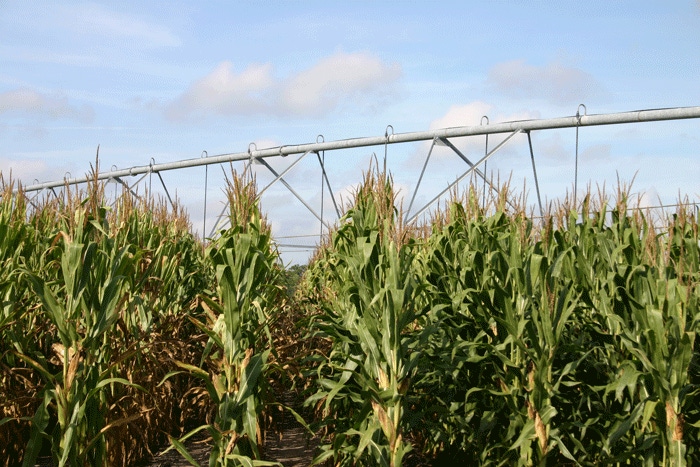
• Any stress now guarantees some yield loss depending on the length of the plant stress and its growth stage. • Irrigating to meet the crop demand is difficult given the evapotranspiration rates of corn and the current available water supply.• Moisture stress has the most adverse effect on corn yields when it occurs two weeks before and two to three weeks after pollination.
June 9, 2011

Water supplies are tightening in Georgia and, unfortunately, a large portion of the corn crop is at the most critical stages of water demand. And, weather conditions are still dry and very hot.
Any stress now guarantees some yield loss depending on the length of the plant stress and its growth stage.
Irrigating to meet the crop demand is difficult given the evapotranspiration rates of corn and our current available water supply.
Moisture stress has the most adverse effect on corn yields when it occurs two weeks before and two to three weeks after pollination. Yield losses can range up to 90 percent under extended drought conditions.
For instance, studies conducted in Michigan show that drought beginning just prior to tassel emergence for six days, 12 days, and 18 days resulted in a 22 percent, 46 percent and 92 percent yield loss, respectively. This was due to a delay in silk emergence and lack of pollination resulting in a loss of kernel numbers.
Other studies have shown that as little as four days of wilt during the silking stage can reduce yields by 50 percent or more.
As you see, the most critical time to keep corn from stress is from tassel emergence to at least 18 days later (this roughly coincides with the beginning of the milk stage). It is extremely important to understand the demand for water during this period and make sure to supply ample water.
Unfortunately, we know that corn growers in Georgia are beginning to wonder if they will be able to meet this demand. So how do you manage a potential limited water supply in corn?
The following was developed from a discussion that took place at the University of Georgia, Tifton Campus on Monday, June 6. In attendance were, Jim Hook, retired water and soil scientist; Dewey Lee, Extension grain agronomist; three representatives from Pioneer and two from Monsanto; David Wright, University of Florida grain agronomist; and Brenda Ortiz, Auburn University grain agronomist. Several climatologists also were in attendance.
What should you do if you don’t have enough water to finish the crop?
If you discover that surface water supplies are getting short at tassel stage, it is critical the majority of the water be supplied to corn for the next 18 days following tasseling.
Given the current temperatures, wind and humidity, corn water needs will range from .32 to .34 inches per day in this period. Do not ration or shut water off through this period as drought stress will reduce kernel set due to the lack of pollination and kernel abortion and cause the greatest yield loss.
If you have managed to maintain good water supply and you are able to apply .75 inches to 1 inch every third day, your crop will not suffer. You may stretch this to the fourth day without significantly affecting yield. Longer delays can cause stress.
Formula for minimum loss
If you know you only have enough water for four irrigations at the time of tasseling, then apply water as described, but after the second irrigation, add a two-day delay between the second and third irrigation and three days between the third and fourth irrigations. This will get you through the critical time with a minimum of loss.
Yield loss due to a water shortage is mitigated the further the kernels develop and mature prior to the stress as long as the soil profile is fully charged at the time water shortage occurs. That is why we say it’s best to use the majority of your water during this critical stage.
After 18 days-plus past the tassel stage, the kernel number is set and the milk stage begins. Drought stress during this time period will reduce kernel size and lead to some yield loss.
Studies have shown that the yield reduction is due mostly to kernel weight loss. At this point, a continuous two-day delay in irrigation applications will not severely damage your yield. Studies have shown a 5 to 20 percent loss can be expected. In this case, if you apply 1 inch every third day as described above, you may stretch to the fifth day without severely affecting yield.
If enough water is available, maintain this schedule. The further the crop matures the longer the less water is required to finish the crop.
In cases of very limited water, consider the following conservation suggestions. The goals of these conservation practices are to use the limited water supply in the most profitable way for the most return on your investment.
• Consider shutting off the end gun. End guns are major outlets of pressure and water and often irrigate non-crop areas (roads, pine trees, etc). Also, the areas under the end guns generally have much lower yield potential particularly under current conditions.
• Sacrifice the lower yield potential areas (end guns areas, soils with nematodes or nutritional problems etc). Minimize the amount of time the pivot walks through or over non-crop areas.
• Evaporative losses for two 0.5 inch applications are greater than for a 1-inch application, therefore, make your irrigation applications as much as possible prior to the point of run-off.
• In cases of shared water sources for separate fields, focus on the corn that is in the critical 18-day period we have discussed.
These are, hopefully, helpful suggestions to maximize your return during this critical drought. Each situation will be different and results will vary for each strategy taken.
You May Also Like



